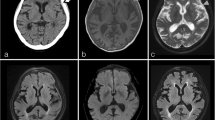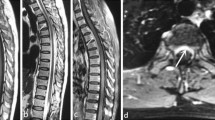Abstract
The aim of this study is to study the clinical, laboratory, imaging pathology, and prognosis features of IgG4-related spinal pachymeningitis. We worked with a 55-year-old man suffering from IgG4-related spinal pachymeningitis who had the most widespread lesion in his dura mater. We also review previous related studies and discuss the clinical characteristics of this rare disease. In total, eight IgG4-related spinal pachymeningitis patients have been reported in the literature since 2009. They were mostly male patients, 51.7 ± 11.9 years old on average. Cervical and thoracic vertebrae were the most common sites for lesions. The most prominent symptom was varying numbness and weakness of the limbs and/or body associated with spinal cord compression. There was one patient (1/5) with elevated serum IgG4 levels and three patients (3/3) with increased cerebrospinal fluid (CSF) IgG4 index. Positive histopathologic findings are the strongest basis for a diagnosis. All the patients with IgG4-related spinal pachymeningitis responded well to glucocorticoid therapy. IgG4-related spinal pachymeningitis is an orphan disease that mainly occurs in cervical and thoracic vertebrae. Older males are the most susceptible group. Serum IgG4 levels were consistently normal in these cases, so analysis of CSF for IgG4 production (IgG4 index) could become a useful tool. Pathological findings remain the gold standard for diagnosis. Most patients responded favorably to glucocorticoid treatment.



Similar content being viewed by others
References
Stone JH, Zen Y, Deshpande V (2012) IgG4-related disease. N Engl J Med 366(6):539–51
Masaki Y, Dong L, Kurose N et al (2009) Proposal for a new clinical entity, IgG4-positive multiorgan lymphoproliferative syndrome: analysis of 64 cases of IgG4-related disorders. Ann Rheum Dis 68(8):1310–5
Sato Y, Notohara K, Kojima M, Takata K, Masaki Y, Yoshino T (2010) IgG4-related disease: historical overview and pathology of hematological disorders. Pathol Int 60(4):247–58
Brito-Zeron P, Ramos-Casals M, Bosch X, Stone JH (2014) The clinical spectrum of IgG4-related disease. Autoimmun Rev 13(12):1203–10
Pieringer H, Parzer I, Wohrer A, Reis P, Oppl B, Zwerina J (2014) IgG4- related disease: an orphan disease with many faces. Orphanet J Rare Dis 9:110
Lu LX, Della-Torre E, Stone JH, Clark SW (2014) IgG4-related hypertrophic pachymeningitis: clinical features, diagnostic criteria, and treatment. JAMA Neurol 71(6):785–93
Dyck PJ, Boes CJ, Mulder D et al (2005) History of standard scoring, notation, and summation of neuromuscular signs. A current survey and recommendation. J Peripher Nerv Syst 10(2):158–73
Della TE, Bozzolo EP, Passerini G, Doglioni C, Sabbadini MG (2012) IgG4-related pachymeningitis: evidence of intrathecal IgG4 on cerebrospinal fluid analysis. Ann Intern Med 156(5):401–3
Della-Torre E, Passerini G, Furlan R et al (2013) Cerebrospinal fluid analysis in immunoglobulin G4-related hypertrophic pachymeningitis. J Rheumatol 40(11):1927–9
Chan SK, Cheuk W, Chan KT, Chan JK (2009) IgG4-related sclerosing pachymeningitis: a previously unrecognized form of central nervous system involvement in IgG4-related sclerosing disease. Am J Surg Pathol 33(8):1249–52
Choi SH, Lee SH, Khang SK, Jeon SR (2010) IgG4-related sclerosing pachymeningitis causing spinal cord compression. Neurology 75(15):1388–90
Lindstrom KM, Cousar JB, Lopes MB (2010) IgG4-related meningeal disease: clinico-pathological features and proposal for diagnostic criteria. Acta Neuropathol 120(6):765–76
Tajima Y, Mito Y (2012) Cranial neuropathy because of IgG4-related pachymeningitis; intracranial and spinal mass lesions. BMJ Case Rep. doi:10.1136/bcr-2012-006471
Wallace ZS, Carruthers MN, Khosroshahi A et al (2013) IgG4-related disease and hypertrophic pachymeningitis. Medicine (Baltimore) 92(4):206–16
Kosakai A, Ito D, Yamada S, Ideta S, Ota Y, Suzuki N (2010) A case of definite IgG4-related pachymeningitis. Neurology 75(15):1390–2
Author information
Authors and Affiliations
Corresponding author
Ethics declarations
Disclosures
None.
Funding
China-Japan Friendship Hospital Youth Science and Technology Excellence project (2014-QNYC-B-11, 2014-QNYC-A-03).
Rights and permissions
About this article
Cite this article
Lu, Z., Tongxi, L., Jie, L. et al. IgG4-related spinal pachymeningitis. Clin Rheumatol 35, 1549–1553 (2016). https://doi.org/10.1007/s10067-015-3104-x
Received:
Revised:
Accepted:
Published:
Issue Date:
DOI: https://doi.org/10.1007/s10067-015-3104-x




